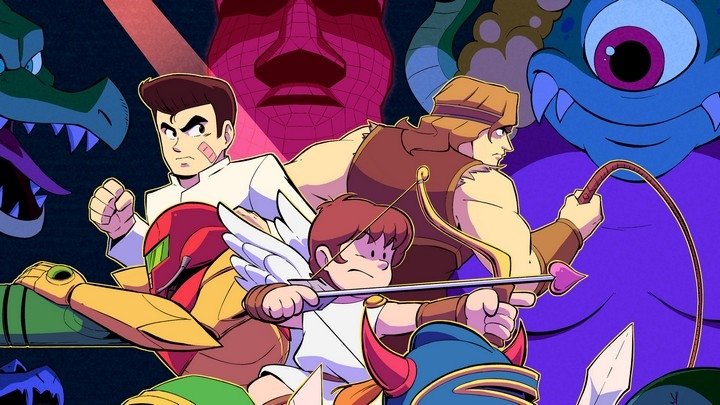A decade on: The legacy of Super Mario Galaxy, Assassin's Creed, and Contra 4
Three major releases turn 10 this week. Here's what they can tell us about the past and present of gaming.
We're a decade out from one of the biggest weeks of game releases ever. The middle chunk of November 2007 saw new games in an enormous range of major franchises: Sonic the Hedgehog, Tomb Raider, Metal Gear, Medal of Honor, LEGO Star Wars, and more. However, three games in particular stand out in light of what they represent 10 years later.
On Nov. 12, Nintendo reinvented the 3D Mario games with Super Mario Galaxy. The following day, Konami boldly launched the first numbered entry in the Contra series in 15 years, shipping Contra 4 for the humble DS. And finally, on Nov. 16, Ubisoft debuted the Assassin's Creed series. Each of these games plays very differently from one another, and each occupies a very different place in its respective franchise.
Super Mario Galaxy shines as the standout game in the trio. Aside from the usual spit-and-polish Nintendo lavishes on its most important character's adventures, Galaxy also deserves praise for the way in which it picked up a troubled thread of the series' evolution and brought it some much-needed reinvention. Super Mario 64 effectively defined 3D video games back in 1996, but it was a bit rough in hindsight — which is to be expected for a game that basically made up a new style of play as it went along. Meanwhile, although Super Mario Sunshine had its moments, it frequently fell victim to clumsy camera controls, overly complex controls, and a weirdly unforgiving checkpoint system.
Super Mario Galaxy stripped things down considerably, as a matter of necessity: The Wii remote control lacked the breadth of control options available on the GameCube pad, even with the nunchuck dongle attached. Galaxy extracted most (though not all) of the free-3D-camera sequences of its predecessors, instead emphasizing a more instanced approach with restricted camera angles and diorama-like spaces. By reclaiming much of the point-of-view control from players, Galaxy's designers could instead present greater spectacle (things like that crazy intergalactic war fleet or the final run-up to Bowser down a gravity-defying lava tube) while loading the game down with fairer and more polished play challenges that relieved players of the anxiety of wrestling with a slippery camera as they navigated platforms and obstacles.

In many ways, Assassin's Creed did much the same thing. Although it kicked off a brand new property for Ubisoft, it emerged directly from the Prince of Persia series. Many of Creed's central mechanics built on ideas Ubi had explored in Prince of Persia: The Sands of Time and its sequels. On one level, Creed represented a diametric opposite to Galaxy: Where Galaxy battened down its play spaces to create a more guided experience, Creed opened Prince of Persia's structured levels into wide-open sandbox environments that players could traverse freely. What the two games had in common was their shared drive toward simplification.
Even though Creed dropped players into more free-form environments than we saw in Prince of Persia, the game's driving ethos was streamlining. Running, leaping, and scrambling across cityscapes amounted to pressing in a given direction while holding a button; protagonist Altaïr dealt with the complexities of scrambling and jumping across precarious structures automatically. Likewise, combat and assassinations played out through simplified interface, revolving largely around two buttons: Attack and evade. Even hiding from pursuing enemies became far simpler than it had been in the likes of Metal Gear Solid or even Ubisoft's own Splinter Cell games: Altaïr need only find a conveniently placed hiding spot or press the "blend in" button while mingling with other hooded men. Creed didn't quite play itself, as some critics claimed, but it made its sprawling systems and world approachable for a mass audience by sanding down anything that even vaguely resembled mechanical friction.

Contra 4, by contrast, stood in defiance of this trend of simplification. Rather than strip out mechanics or constrain players, it amplified the complexity of its predecessors. Konami and WayForward's designers allowed the 2D shooting action to span both screens of the DS system, doubling the active screen space that could spew bullet and other hazards at the players. Contra 4 also added a new control mechanism to the series' sandbox as a way to compensate for the increase in active play space: A grappling hook, which allowed the protagonists to travel upward across the two screens almost instantaneously. On top of that, Contra 4 pushed back on the series' prevailing design trend of constant boss encounters connected by brief interstitial segments in favor of interestingly structured stages reminiscent of the first two Contra arcade games, back in the ’80s. While Galaxy and Creed embraced the largest possible audience by emphasizing mechanical accessibility, Contra 4 looked to its own history to create a greater appeal to a narrower, more dedicated slice of the gaming market.
Perhaps it's no coincidence, then, that the Contra series is the one that doesn't appear to have survived into the present day. Konami produced only two more "real" Contra titles following Contra 4, and aside from some furtive mobile cash-ins, the series appears to be dead. On the other hand, considering Konami didn't even bother to call one of those two games "Contra" (instead taking a classic Contra subtitle from the ’90s and grafting on an all-new subtitle to create Hard Corps: Uprising), perhaps the problem with Contra has less to do with the series' creative direction or targeted focus and more to do with the company behind it.
Things haven't been smooth sailing for Assassin's Creed, either. The original game sold exceptional well, but it met with uneven critical reception. Ubisoft rectified many of its flaws for the sequel, which was a marked improvement over the first game, but they also took the series to an annual schedule and quickly hit a point of diminishing returns. This year's entry — Assassin's Creed: Origins — arrives after a year of laying fallow; while it doesn't reinvent any wheels, it nevertheless brings refreshing changes to bear. Perhaps most appealingly, Origins finally fully embraces the historic premise of the franchise by incorporating an "educational" mode that allows players to roam freely through its ancient Egyptian setting. There's a distinct possibility that sequel fatigue could easily settle over the series if Ubisoft doesn't tread carefully, but for the moment, the company appears to have righted the ship.

Arguably, it's been Super Mario Galaxy that's proven to have the most resilience. While it only inspired a single direct sequel — Super Mario Galaxy 2, also for Nintendo Wii — the fundamental thinking behind the game's design has percolated throughout the entire Mario series. Super Mario 3D Land and Super Mario 3D World both adopted a Galaxy-esque constrained camera system; 3D World in particular felt like a direct descendent of Galaxy, but with four-person multiplayer. Speaking of multiplayer, Galaxy's asymmetric multiplayer has become a recurring feature in the Mario series, with an especially prominent role in New Super Mario Bros. U and Super Mario Odyssey. And, really, Odyssey owes a great debt to Galaxy: The Wii game's more buttoned-down approach to 3D action versus Super Mario 64 and Sunshine helped Nintendo's designers create a better free camera system for Odyssey.
Taken together, Contra 4, Assassin's Creed, and Super Mario Galaxy do paint a remarkably accurate picture of how the games business has related to its history over the past decade. With Contra 4, we have the old giants who have fallen by the wayside. Assassin's Creed demonstrates both the potential of creating something new from threads of the old and the perils of relying on formulaic annualization. Finally, Super Mario Galaxy represents a venerable brand managed effectively, with thoughtful design choices and a willingness to experiment amidst iteration. Where do you think these series will be a decade from now?




